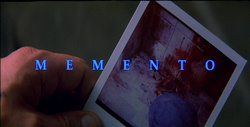The Form Is the Function
 Memento is such a triumph of tricky narrative structure that it’s difficult to get (and keep) a grip on what happens, let alone the objective truth of its protagonist’s past. Christopher Nolan’s second feature, which he wrote and directed based on his brother Jonathan’s short story, seems perpetually slippery and elusive. I’ve seen it at least six times since it was released in the U.S. in 2001 (it debuted at festivals in September 2000), and even though I know it well, each time it repeatedly throws me off. The movie’s closing line – in context, a sick joke by Nolan – is an excellent summary of how I feel watching it: “Now … where was I?”
Memento is such a triumph of tricky narrative structure that it’s difficult to get (and keep) a grip on what happens, let alone the objective truth of its protagonist’s past. Christopher Nolan’s second feature, which he wrote and directed based on his brother Jonathan’s short story, seems perpetually slippery and elusive. I’ve seen it at least six times since it was released in the U.S. in 2001 (it debuted at festivals in September 2000), and even though I know it well, each time it repeatedly throws me off. The movie’s closing line – in context, a sick joke by Nolan – is an excellent summary of how I feel watching it: “Now … where was I?”

 Because I do have a memory – not a very good one, but a memory nonetheless – I can save myself some work by providing Rupert Murray – the filmmaker behind Unknown White Male – with a few lessons I’ve learned from other movies and simply link to previous essays.
Because I do have a memory – not a very good one, but a memory nonetheless – I can save myself some work by providing Rupert Murray – the filmmaker behind Unknown White Male – with a few lessons I’ve learned from other movies and simply link to previous essays. A man’s hand holds a Polaroid photograph, but who would want to commemorate such a gruesome scene? The picture shows a body lying face-down on a floor, blood everywhere. This might be a crime-scene photo, but that conclusion doesn’t feel right.
A man’s hand holds a Polaroid photograph, but who would want to commemorate such a gruesome scene? The picture shows a body lying face-down on a floor, blood everywhere. This might be a crime-scene photo, but that conclusion doesn’t feel right.